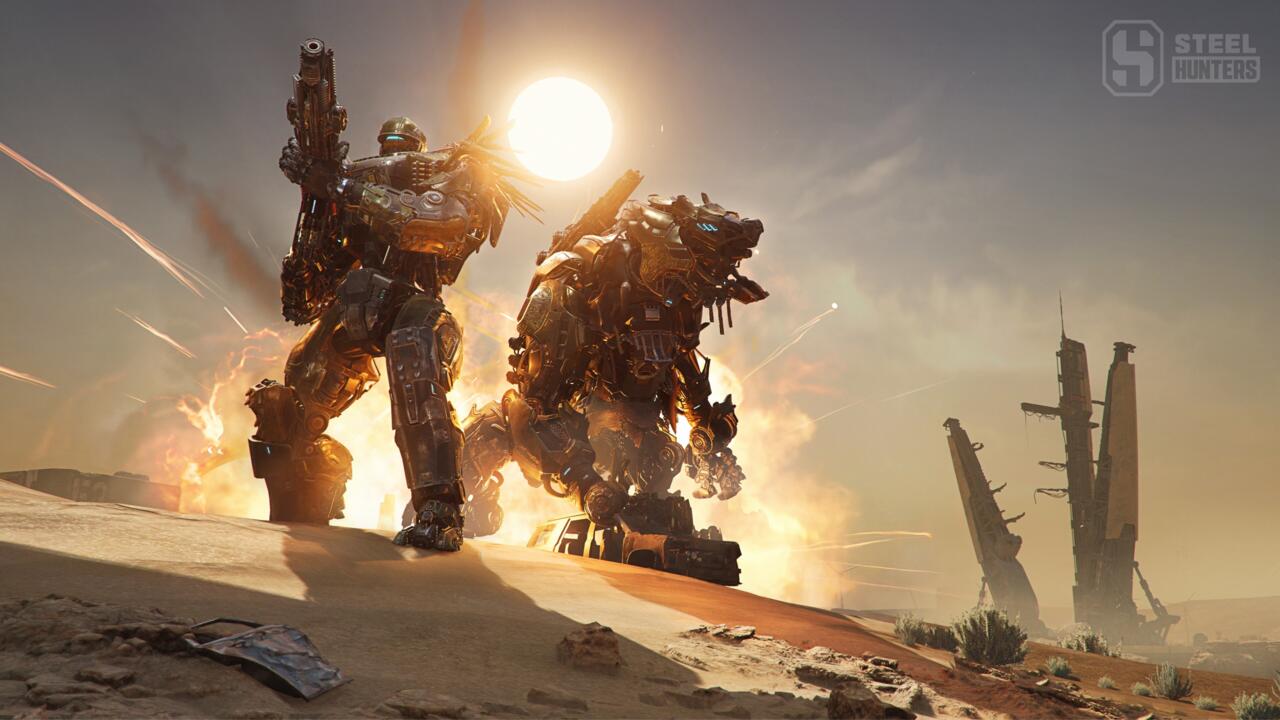Wargaming has built a gaming empire on the multiplayer experience. World Of Tanks put the company on the map back in 2010, and since then, the MMO action game has expanded to the air and sea with World Of Warplanes and World Of Warships. A few new genres of multiplayer games have emerged more recently, and with Steel Hunters, which was revealed during The Game Awards, Wargaming hopes to challenge them all… at the same time.
Steel Hunters is a free-to-play PvPvE third-person shooter that combines the unique characters of hero shooters, eliminations of battle royales, and key-item retrieval of extraction shooters into one experience. Each player will choose a character–those characters being massive mechs themed after real-world animals–and pair up to try to win the day, either through surviving or securing the objective.
GameSpot recently attended a hands-off briefing with Wargaming to learn more about Steel Hunters, and while on paper it sounds like it might be trying to do too much, we left the presentation thinking that maybe Wargaming has the formula figured out after all.

Beast wars
Steel Hunters takes place in a version of Earth ravaged by a cataclysmic event, where a rare extraterrestrial element called Starfall has emerged. Starfall is critical to survival–it was referred to by Wargaming marketing director Laurent Lartisien as “the lifeblood of many facilities, like space stations and underground vaults, where humanity is still trying to survive.”
Retrieving this rare element are the Hunters: hulking mechs designed to resemble real-world animals. Fenris, for example, stalks enemies and attacks like a wolf, while the Ursus is a tanky armored bear. Hunters are not piloted like traditional mechs, however, instead they have had human consciousnesses uploaded into them via an experiment with Starfall.
From a narrative perspective, Lartisien says this choice allows the team to be more creative with them, and allow them to have more of a weight than just being glorified vehicles. “Our Hunters have personality,” he says. “They have drives, motivators, and they’re fighting for a specific cause, which is tied back to their individual factions. They’re not just a piece of metal with a gun; they are true characters.”
These Hunters are giants, too; during the gameplay demo, Wargaming head of player interaction Ryan Nicholls noted that maps are filled with real-world objects like big rig trucks and large buildings–“bananas for scale,” as Nicholls nicknamed them–which the Hunters tower over easily. Despite acting like Overwatch-esque heroes, these Hunters are more like Godzilla than Genji.

A mixing of multiplayer elements
Each match in Steel Hunters will feature 12 players–six teams of two players each. Teams will be assigned one of six drop zones scattered around the edges of the map, and each battle progresses through multiple “phases,” with different objectives and opportunities to power up. In the example we were shown, objectives came in the form of Starfall Towers, with three towers unlocking for capture before the final Extraction Zone opened up and the final phase began.
Each match will also offer mid-game events off the beaten path with extra rewards for those who pursue them. One of these objectives is called Tag Hunt, where the player can hunt down CPU enemies and collect tags. If all tags are collected, that player earns a Colossus Kit, which when activated transforms them into an even bigger mech armed with a spear.
Opposing teams aren’t the only dangers while searching for the towers, as the map is populated with CPU-controlled enemies like drones. These enemies drop important items like upgrade cores or health and repair kits needed to scale up and stay alive as a match progresses. Hunters can level up from one to five during a match, with most levels providing stat buffs and level three specifically adding a second unique ability to the list of options.
One notable element in battle is the ammunition system; rather than scattering ammo around the map like in other battle royale games, Hunters have a limited supply of ammo that slowly regenerates over time as long as the gun isn’t firing. This was a deliberate decision made after initial playtesting, according to Nicholls, in order “to ensure that engagements have to be thoughtful. You need to think about every engagement, you need to think about the shots that you take, or else you will lose.”
The most important element to victory is team synergy, which involves choosing the right combinations of Hunters and ability modifications in order to gain an edge. In the demo, Nicholls modifies Fenris’s blink ability to add a heal every time it’s activated, which gives the wolf mech a slight advantage. However, Nicholls also points out that if needed, players can choose a more offensive mod instead, which will instantly reload Fenris’s gun and buff damage for a short time.
Should a Hunter be downed in combat, the game offers a comeback mechanic that allows the downed player to continue to play by healing and buffing their surviving teammate. As long as one Hunter in a pair remains, there’s still a chance the team could reverse their fortunes and end up winning the entire match.


A new type of hunt
The jack-of-all-trades approach to Steel Hunters is a risky one, but the result has a lot going for it. The decision to make each character a massive mech is different and interesting, the focus on customization and team synergy should allow for deep strategic planning, and the objective-based formats will be familiar enough that anyone who plays any of the separate genres Steel Hunters evokes will be able to jump in and feel comfortable from the jump.
Whether or not this becomes Wargaming’s next major success remains to be seen, but the concoction brewing in Steel Hunters has the potential to blow up in popularity… or blow up in their face.
Steel Hunters will launch in open beta on PC in 2025. Players interested in trying it out beforehand can sign up on the game’s official website for a closed play test, which runs from now until December 22.
Source link











Leave a Reply